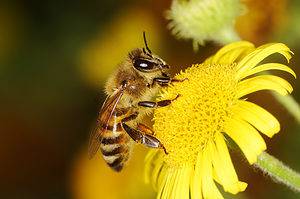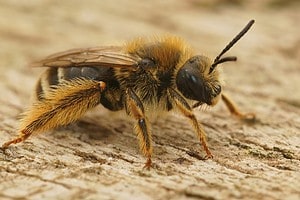Did you know that there are over 20,000 different species of bees? They are all part of the Hymenoptera family which includes ants, wasps, and hornets. With so many different kinds of bees, you may be wondering which kinds live in a hive setting. Only social bees live in colonies, which equal around 5% of the total types of bees. Two of the more popular species of social bees are honey bees and bumble bees. Both of these live in colonies with many other bees of their species where they have jobs and social roles, however, only honey bees live in actual hives. Other popular species of bee are carpenter and sweat bees. These bees are not social and therefore do not live in hives or colonies.
Honey Bee Hive Population
The honey bee, or Apis mellifera, is the most common insect known to live in hives. In their active season, a honey bee hive may have up to 80,000 bees living in it. On average, though, hives contain around 60,000 honey bees.
Types of Honey Bees
Not all bees are created equally. Out of the tens of thousands of female worker bees, there is only one other type of female bee in the colony — the queen. There is only ever one queen bee in a colony, and all of the worker bees protect the queen. Female queen bees appear physically different than worker bees. They have longer legs and longer abdomens than the other females in the hive.
The Role of the Queen Bee
The queen bee has only one job — to reproduce and secure the population of the hive. Though the primary portion of the hive’s population is female, the queen bee is the only one who lays eggs. She lays her eggs in cells that are created by the worker bees. Worker bees have the job of knowing what the colony needs to survive. They create differently-sized cells depending on what the population calls for.
In the regular, smaller cells, the queen will lay one fertilized egg per cell. The eggs that she lays are fertilized by the male drone bees and will grow to become female worker bees. In the larger cells, of which there are much fewer, the queen will lay unfertilized eggs. The unfertilized eggs will grow into male drone bees.
Queen bees have the sole duty of keeping their hives strong and supplied with new bees. This is crucial when the life of a worker bee is only six weeks. Drone bees live for around two months on average.
From Eggs to Adults
The fertilized eggs that the queen bee lays hatch after three days and are then called larvae. Larvae look like little worms and don’t resemble the bees that they will soon grow into. They are cared for and fed royal jelly at first, then switched to a diet of honey and pollen. They grow extremely quickly due to their voracious eating habits. After around five days of constant eating, the larva begins to change again. Worker bees seal off their cells with wax and the larva spin a cocoon around themselves and wait. During this time of metamorphosis, the larva is growing into a pupa. At this point, they are beginning to look more like adult bees, and have developed wings, legs, and eyes.
After about one to two weeks in their pupa, the now-adult bees chew their way through the wax coating and join the rest of the hive.
Queen Bee Lifespan
Queen bees are capable of producing up to 2,000 eggs per day. They are able to live much longer than the female worker bees, up to five years. However, because they are usually only able to produce eggs for two to three years, they are often killed after production slows.
When a queen bee is either killed or replaced, a new queen is groomed to take her place. The new queen is chosen during the larva stage of life and fed a diet of royal jelly. While all larvae receive royal jelly for a short time, the future queen will be fed it for her entire life. This is what makes her grow into a sexually mature bee that is able to take the place of the current queen.
Worker Bees
The worker bees are the only other female bees, and they make up the largest portion of the colony. Despite being female, they do not produce eggs aside from a few special circumstances. They don’t reproduce because they are aware that it is the queen’s job to create eggs for the colony. The queen sends out specific pheromones that tell them this. They exist solely to protect and do work for the colony and the queen, with their role in the hive depending on their stage of life.
The Role of the Worker Bee
In their first few days of life, worker bees are on cleaning duty. This quickly changes into nursing, when they will take care of and feed the young larva. After this, they may do a few different jobs.
Some worker bees take the responsibility of fanning, or flapping their wings to maintain the temperature of the hive. At a similar time in life, they begin producing wax from below their bellies. They are then responsible for taking the wax and molding it, often using it to encapsulate the larva that are ready to become pupas. Around this time, which is two weeks or so into their lifespan, they gain a new role.
They become responsible for meeting the older, foraging bees and carrying the nectar back to the hive. When they bring it into the hive they put it into cells and fill the cells with an enzyme that helps the nectar ripen into honey.
Guarding and Foraging
After their stinger is developed, the worker bees can take on the role of guarding the hive. They will protect the hive against rival bees and other unwanted visitors. They do this using their keen sense of smell, by sitting at the hive entrance and smelling the bees coming in. If there are unwelcome visitors, it is the guard bees’ job to fight them off with their life.
The last job a worker bee will have is foraging. They usually begin foraging in the middle of their life and will continue until the end. Foraging is a dangerous but necessary job for the hive, as the foraging bees provide all other worker bees and drone bees with food. Foraging worker bees collect nectar from flowers around the hive, and can carry up to half of their body weight in nectar!
Drone Bees
Drone bees are the only male bees who live in the colony. There are a few hundred drone bees per colony, and they have just one job — to fertilize the queen’s eggs. They have no stinger, don’t create honey, and have no other job. Also, since the queen only mates once during her life, most males will never fulfill their one role. Still, these drone bees are kept around just in case a new queen is needed. However, in the fall, some colonies will force out the drone bees due to a lack of food.
Bumble Bees, Carpenter Bees, and Other Bees
While honey bees are the most popular and well-known species to live in hives, bumble bees also are social bees. They live in colonies underground made up of around 500 bumble bees. They will sometimes make a nest above ground but do not live in hives like their honey bee relatives.
Carpenter bees are not social bees and do not live in hives or even colonies. The adults are known to overwinter alone and reproduce in the springtime. The female bee burrows into a piece of wood to lay her eggs and protect her young, which is likely where the “carpenter bee” name came from.
Sweat bees are another popular type of bee that isn’t social, so they don’t live in colonies of hives. Because of this, they aren’t very aggressive and are simply great pollinators.
The photo featured at the top of this post is © iStock.com/Inventori
Thank you for reading! Have some feedback for us? Contact the AZ Animals editorial team.






